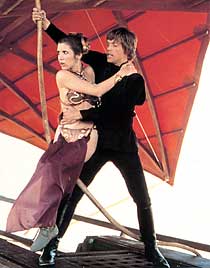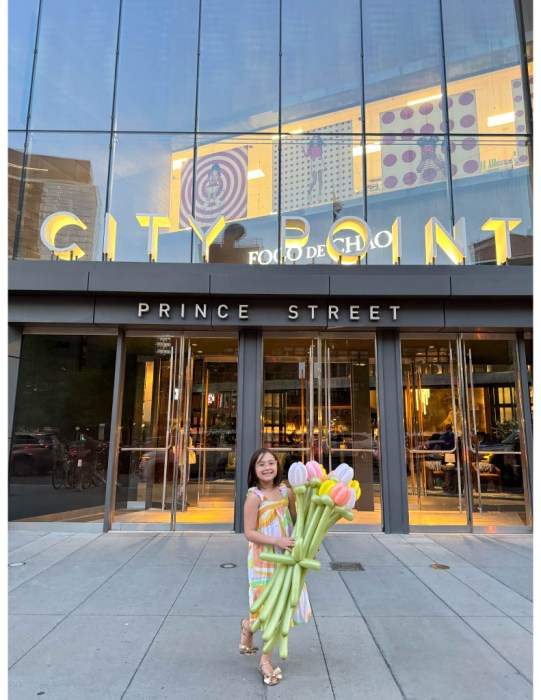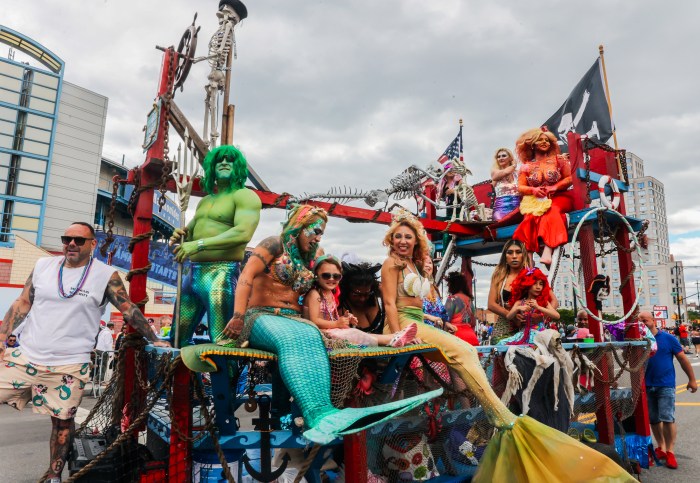Star Wars: The Magic of Myth," the
new exhibit at the Brooklyn Museum of Art, may make most museum-goers
feel ill at ease. The objects on display – models, costumes and
storyboards from the four "Star Wars" films that have
been released to date – are, for the most part, not the conventional
stuff of art exhibits.
So the museum chooses not to treat them as pieces of art.
Instead of profiling the artists involved in creating the pieces
– their training, where they lived, what materials they used
– the exhibit text chooses to deconstruct the narrative of the
films.
To set these artifacts in the context of the wider world of art
history, the Brooklyn Museum has created an entrance to the "Star
Wars" show called, "The Myth of the Hero and Heroine,"
which is meant to examine how diverse cultures throughout history
have explored many of the universal, mythic themes presented
in the "Star Wars" films. There’s an ancient marble
head of Cleopatra VII and Porter Blake screenprints for "Alice
in Wonderland" as examples of early heroines.
While these seemed surprising choices for the heroines who preceded
Princess Leia, I was impressed by the Museum’s inclusion of a
wood Pandanus Club from Melanesia, Fiji Islands. The club, according
to the exhibition notes, was the inspiration for the Tusken Raiders’
weapon, the gaderffi sticks, in "Star Wars," which
is on display a few rooms away. The islanders believed the club
had a supernatural force, a "mana," which would strengthen
with each success in battle. This was a wonderful insight into
the film, into this weapon and into the islanders’ culture.
It set me up for disappointment.
When looking at the first "Star Wars" film artifact,
the 10-foot production model, the "Imperial Star Destroyer,"
there appears to be a coffee stain on its top – as if someone
rescued this child’s model from their garage and decided to put
it under glass. There is no noticeable placard listing the materials
used in making the model or giving credit to an artist.
The triangular shape of the destroyer can be admired for its
original design, but really it is a trigger for the memory of
the scene in the film when it made its appearance. It seems that
in "Star Wars: The Magic of Myth," the artist who really
deserves the kudos is filmmaker George Lucas, because with lighting
and film, he made this model look like an enormous monolith moving
through the black starry night of a galaxy far away. Alone, the
model seems rather lackluster.
This theme is repeated when looking at the costumes on display.
There’s Princess Leia’s "Slave Girl" costume from "Return
of the Jedi." The purplish skirt that billowed in the desert
scene as she and her cohorts escaped from the huge slug-like
Jabba the Hutt creature looks cheap and chintzy. What appears
stunning on film, here loses its glamour when seen up close –
and without the form of actress Carrie Fisher.
While some models, such as Anakin Skywalker’s miniature "Podracer"
from the most recent film "Star Wars: Episode I – The Phantom
Menace" and the lifesize Imperial Speeder Bike (akin to
a motorcycle) might excite racing car buffs and Harley enthusiasts,
most of the costumes and models appear, well, fake and pointless
without the magic of lights, camera and action.
The Asian-inspired Queen Amidala costume, worn by actress Natalie
Portman in the Galactic Senate scene in "Phantom Menace,"
stands apart for its high-quality fabrics, detailing and original
design. From the orange, iridescent, pleated dress to the cape
of red, embroidered velvet, it’s a lush vision of opulence. Here,
"Queen Concept drawings" give credit to Iain McCaig,
but who crafted the costume?
I had preconceived notions that this show might break down the
art of special effects and computer animation, showcase the creatures
of "Star Wars" or display more such exquisite costumes.
The less-than-popular character Jar Jar Binks of "Phantom
Menace" was an actor-less character created and animated
using computers; it would have been interesting to see an exhibit
about this new digital artform of which Lucas is a master.
"Star Wars: The Magic of Myth," developed by the Smithsonian’s
National Air and Space Museum and organized for travel by the
Smithsonian Institution Traveling Exhibition Service, had so
many possibilities.
The show could have displayed all of the glorious creatures from
the "Star Wars" films. (I’m not the first to think
of this – there’s a "Star Wars" book in the gift shop
called "Guide to Wildlife and Aliens.") In this exhibit,
the highlights include the small Jabba the Hutt and Yoda models,
and while these characters are the most well-known, there were
so many more creatures in the films that could have been featured.
Exhibit designer Matthew Yokobosky dedicated one entire alcove
to "Yoda," evoking the swamp scene in "Empire
Strikes Back" by painting the space green and running cords
from the floor to the ceiling, giving the effect of elongated
swamp grass. It is a triumph of exhibition design, trumped only
by "Yoda" himself, a humorous sculpture of a wizened,
lizard-like creature in a tattered Eastern robe.
Nearby, the concept drawings, by Ralph McQuarrie, demonstrate
how the idea of Yoda became more beneficent – ears pointy to
ears folding over, lips softened and around his eyes, laugh lines
added. This model is displayed so the visitor can walk around
it and notice his hunched back – like a victim of osteoarthritis.
His frayed robe is akin to a wise, elderly man’s cardigan. In
this alcove, there is also a film clip of Yoda in action in "Empire
Strikes Back."
I expected more of this substance – seeing the artistic process
through sketches and models.
Both "droids" C-3P0 and R2-D2 stand up to close scrutiny
as does Darth Vader’s costume – it’s just as black and impenetrable
as in the films, but the tall, brown-fur Chewbacca costume and
crouching white-fur Wampa Ice Creature costume are cheaply crafted
in a stuffed-animal (with sharp teeth) sort of way.
Another theme for the show might have been how, through visual
cues, Lucas manipulated viewers’ emotions. The designers made
Luke’s flight suit by using elements of the American Navy’s orange
jumpsuits. The uniforms of the Imperial Officers have the black
boots and mandarin collars of Nazi uniforms. It’s clear from
these visual cues who are the good guys and who are the bad guys.
Han Solo’s costume incorporates elements of Western movie costumes.
His gun sits in a holster on his hip. Clearly Han Solo is the
renegade living outside the law. Unfortunately, this information
about the designers’ inspiration – and how it relates to characters’
roles in the film – is not made available to exhibit visitors.
The comic book-like storyboards – some drawings, some watercolor
– do give valuable insight to the visitor, as it’s amazing to
see how much goes into a storyboard: from the characters in the
scene to the camera angle.
This is the last U.S. stop of this traveling exhibit of some
of the artifacts, all on loan from the archives of Lucasfilm
Ltd., from the making of Lucas’ original "Star Wars"
(1977), "The Empire Strikes Back" (1980), "Return
of the Jedi" (1983) and "The Phantom Menace" (1999).
A space has been reserved in the show for artifacts from "Star
Wars: Episode II – Attack of the Clones," which will be
installed after that film is released in May.
"Star Wars: The Magic of Myth" is an exhibit that is
sure to draw tri-state fans of the movie – as was evidenced by
the appearance of fans in costume at the exhibit’s media preview.
But then, the museum is hoping this exhibit will attract a whole
new audience who may not have visited before and might return
to see other shows. If that’s the museum’s intention, the emphasis
should be placed on the artists and less on the pieces’ roles
in the movies from which they came. As an art lover – and movie
lover – I expected, and wanted, more substance.
"Star Wars: The Magic of Myth"
is on display at the Brooklyn Museum of Art (200 Eastern Parkway)
through July 7. For tickets ($10, $8 seniors and students, $4
children) call (866) 606-R2D2. The audio tour is $5, $3 children
ages 612.
All four films will be screened at the museum: "The Phantom
Menace" on April 20 at 10 am and 3 pm; "Star Wars"
on April 20 at 12:30 pm and 5:30 pm; "The Empire Strikes
Back" on April 27 at 10 am and 3 pm; and "Return of
the Jedi" on April 27 at 12:30 pm and 5:30 pm. Admission
to each film is $6, $3 students and seniors, $2 children under
12. Museum admission is complimentary with film ticket purchase.
For more information, call (718) 638-5000 or visit the Web site,
www.brooklynmuseum.org.























